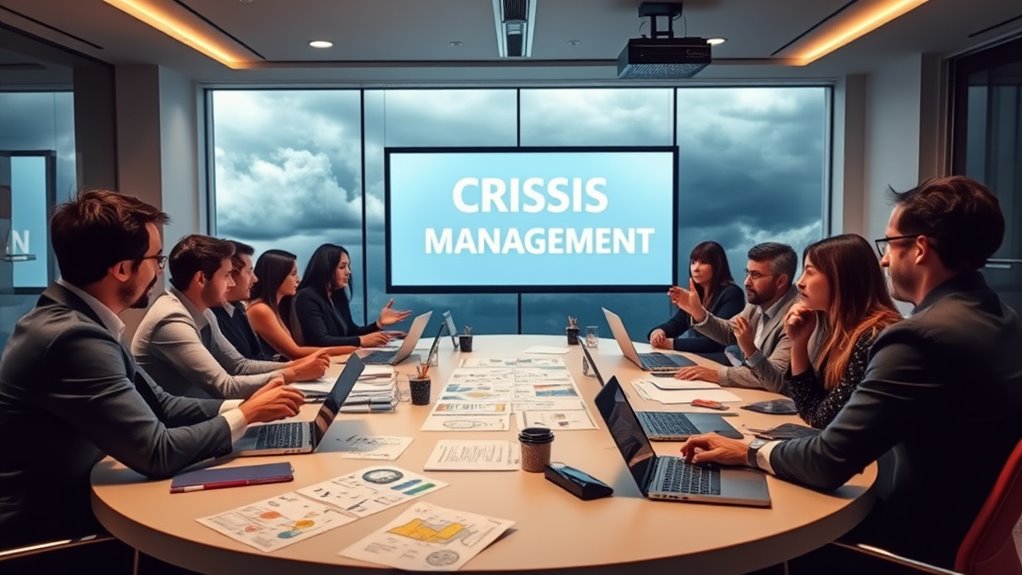Crisis management prepares you to tackle unexpected challenges that might disrupt your business operations. Start by assessing risks and setting up a dedicated crisis leadership team. Develop effective communication strategies and implement crisis response plans to prioritize safety and protect your reputation. After a crisis, analyze the situation to learn valuable lessons and enhance future preparedness. There’s a lot more to uncover about effective strategies that can fortify your organization against crises.
Key Takeaways
- Conduct thorough risk assessments to identify potential crises specific to your industry and organization.
- Establish a cross-functional crisis leadership team with defined roles and communication protocols for efficient response.
- Train employees regularly and conduct simulation exercises to enhance preparedness for unexpected events.
- Implement effective communication strategies that prioritize transparency and stakeholder safety during a crisis.
- Review and document lessons learned post-crisis to refine strategies and improve future preparedness.
Understanding Crisis Management and Its Importance

Crisis management is essential for any organization, as it prepares you to handle unexpected challenges that can threaten your operations and stakeholders.
It’s the process of addressing disruptive events, whether they’re natural disasters, technological failures, or financial crises. You’ll face common elements like surprise threats and tight decision-making windows.
Unlike risk management, which focuses on prevention, crisis management tackles issues before, during, and after they emerge. By having a solid crisis management plan, you can protect your organization’s reputation, minimize financial losses, and ensure the safety of your stakeholders.
Ultimately, effective crisis management supports business continuity and sets the stage for long-term success, making it a critical component of your organizational strategy.
Steps for Effective Pre-Crisis Preparation

Preparing for potential crises involves a proactive approach that can significantly reduce the impact of unexpected events on your business.
Start by conducting thorough risk assessments to identify systemic risks unique to your industry. Implement strategic trend monitoring to catch weak signals early.
Conduct comprehensive risk assessments to uncover industry-specific threats and utilize strategic trend monitoring to detect early warning signs.
Establish a cross-functional crisis leadership team and develop a simple crisis management plan detailing roles and communication strategies. Engage key stakeholders in planning to ensure everyone knows their responsibilities.
Perform business impact assessments to prioritize risks and set recovery time objectives. Develop a crisis communications plan, identify spokespersons, and prepare pre-written content for common scenarios.
Lastly, train employees regularly and conduct simulation exercises to ensure preparedness when a crisis strikes. Additionally, consider cost factors related to your crisis management plan, as they can vary significantly based on the resources and technology you choose to implement.
Implementing Crisis Response Strategies

When an unexpected crisis hits, having a solid response strategy can make all the difference in minimizing its impact on your business.
First, form a crisis team with a clear chain of command, ensuring diverse departmental representation and defined roles. Regularly review this team to adapt to changing needs.
Next, establish effective communication protocols—be transparent and honest, using multiple channels to convey consistent messages that align with your company values.
Act swiftly to assess the crisis and implement pre-planned strategies, prioritizing stakeholder safety.
Finally, focus on reputation management by gathering feedback and monitoring media coverage. This proactive approach not only addresses the immediate crisis but also sets the stage for long-term recovery and improvement.
Analyzing and Learning From Post-Crisis Situations

After implementing effective crisis response strategies, it’s time to focus on analyzing the situation to improve future preparedness.
Start by gathering data from the incident, noting timelines, response effectiveness, and operational impacts. Use feedback mechanisms like surveys and interviews to collect insights from employees, customers, and stakeholders.
Gather data on timelines and response effectiveness, and use surveys and interviews to gain insights from all stakeholders.
Conduct a root cause analysis to identify failures and evaluate your response strategies. Compile a comprehensive report outlining your findings and recommendations, ensuring it’s accessible to all key stakeholders for transparency.
Document the lessons learned to refine your crisis response strategies, update training programs, and revise policies. Engaging with external experts for unbiased opinions can lead to successful co-parenting during difficult transitions, such as a business crisis.
Engage with external experts for unbiased opinions and establish routine reviews of your crisis management plans, emphasizing continuous improvement to enhance resilience.
The Role of Business Continuity Planning in Crisis Management

Effective business continuity planning (BCP) serves as a crucial pillar in crisis management, ensuring that your organization can maintain essential operations during unforeseen disruptions.
BCP shifts your approach from reactive to proactive, allowing you to anticipate crises before they occur. By conducting thorough risk assessments and developing recovery strategies, you can mitigate potential risks and minimize downtime.
This planning not only helps you quickly recover after a crisis but also protects your revenue and reputation. Regular testing of your BCP identifies weaknesses, ensuring that your operational teams are prepared.
Ultimately, integrating BCP with crisis management enhances communication, allowing the right information to reach the right people at the right time, fostering a more resilient organization.
Frequently Asked Questions
How Often Should We Update Our Crisis Management Plan?
You should update your crisis management plan at least annually to keep it relevant and effective.
Regular risk assessments help you identify new threats, while incorporating industry benchmarks ensures you’re prepared.
Don’t forget to gather feedback from stakeholders; their insights can improve your plan.
By conducting drills and training programs, you enhance your team’s preparedness, making your organization more resilient to unexpected events.
Ultimately, timely updates protect your reputation and ensure employee safety.
What Role Does Leadership Play in Crisis Management?
Leadership in crisis management is like a lighthouse in a storm, guiding teams through turbulent waters.
You’ll need to communicate clearly, adapt to changing tides, and empathize with your crew. Proactive problem-solving and strategic decision-making are your anchors, ensuring you navigate challenges effectively.
How Can We Measure the Effectiveness of Our Crisis Response?
To measure the effectiveness of your crisis response, start by evaluating your speed of response and communication effectiveness.
You should collect feedback from stakeholders and conduct post-crisis surveys to gauge satisfaction.
Analyze the financial and operational impacts, including any losses or disruptions.
Finally, assess employee morale and customer retention rates to understand how the crisis affected loyalty.
Use these insights to refine your crisis management strategies for future challenges.
What Are Common Pitfalls in Crisis Management Planning?
When planning for crises, you often fall into common pitfalls like inadequate testing and treating plans as static documents.
It’s crucial you involve senior leadership and assess resources effectively. Ignoring local knowledge and cultural nuances can lead to ineffective strategies, while inflexibility in your plans makes adapting difficult.
Additionally, failing to monitor social media and communicate effectively can exacerbate issues, leaving your organization vulnerable during critical moments.
How Can We Involve Employees in Crisis Preparedness?
Imagine your team as a ship’s crew navigating stormy seas. To prepare for crises, involve your employees in every step of the planning process.
Encourage them to identify risks, develop communication strategies, and participate in training drills. Foster a culture of open feedback, ensuring everyone feels heard.
Conclusion
In the unpredictable storm of business, preparing for crises is your sturdy lifeboat. By understanding the waves of potential challenges and crafting a sound response plan, you can navigate through the rough waters with confidence. Remember, every crisis is a lesson waiting to be learned, shaping your future resilience. Embrace the unexpected, and let your business emerge not just intact, but stronger and wiser. After all, it’s not just about surviving the storm; it’s about dancing in the rain.










